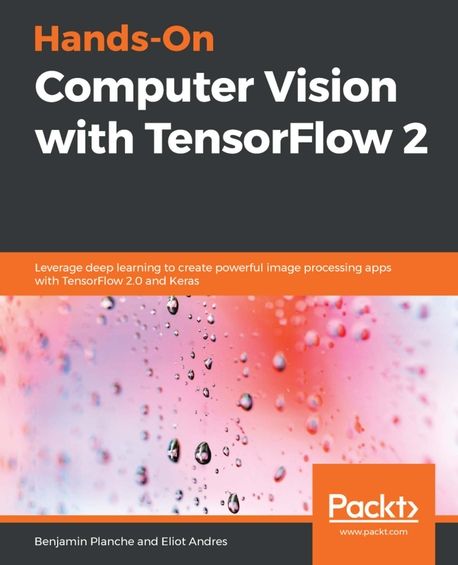Hands-On Computer Vision with TensorFlow 2
2019년 05월 30일 출간
- eBook 상품 정보
- 파일 정보 PDF (20.36MB)
- ISBN 9781788839266
- 지원기기 교보eBook App, PC e서재, 리더기, 웹뷰어
-
교보eBook App
듣기(TTS) 가능
TTS 란?텍스트를 음성으로 읽어주는 기술입니다.
- 전자책의 편집 상태에 따라 본문의 흐름과 다르게 텍스트를 읽을 수 있습니다.
- 이미지 형태로 제작된 전자책 (예 : ZIP 파일)은 TTS 기능을 지원하지 않습니다.
PDF 필기가능 (Android, iOS)

쿠폰적용가 13,500원
10% 할인 | 5%P 적립이 상품은 배송되지 않는 디지털 상품이며,
교보eBook앱이나 웹뷰어에서 바로 이용가능합니다.
카드&결제 혜택
- 5만원 이상 구매 시 추가 2,000P
- 3만원 이상 구매 시, 등급별 2~4% 추가 최대 416P
- 리뷰 작성 시, e교환권 추가 최대 200원
작품소개
이 상품이 속한 분야
Computer vision solutions are becoming increasingly common, making their way in fields such as health, automobile, social media, and robotics. This book will help you explore TensorFlow 2, the brand new version of Google's open source framework for machine learning. You will understand how to benefit from using convolutional neural networks (CNNs) for visual tasks.
Hands-On Computer Vision with TensorFlow 2 starts with the fundamentals of computer vision and deep learning, teaching you how to build a neural network from scratch. You will discover the features that have made TensorFlow the most widely used AI library, along with its intuitive Keras interface, and move on to building, training, and deploying CNNs efficiently. Complete with concrete code examples, the book demonstrates how to classify images with modern solutions, such as Inception and ResNet, and extract specific content using You Only Look Once (YOLO), Mask R-CNN, and U-Net. You will also build Generative Adversarial Networks (GANs) and Variational Auto-Encoders (VAEs) to create and edit images, and LSTMs to analyze videos. In the process, you will acquire advanced insights into transfer learning, data augmentation, domain adaptation, and mobile and web deployment, among other key concepts.
By the end of the book, you will have both the theoretical understanding and practical skills to solve advanced computer vision problems with TensorFlow 2.0
▶What You Will Learn
- Create your own neural networks from scratch
- Classify images with modern architectures including Inception and ResNet
- Detect and segment objects in images with YOLO, Mask R-CNN, and U-Net
- Tackle problems in developing self-driving cars and facial emotion recognition systems
- Boost your application’s performance with transfer learning, GANs, and domain adaptation
- Use recurrent neural networks for video analysis
- Optimize and deploy your networks on mobile devices and in the browser
▶Key Features
- Discover how to build, train, and serve your own deep neural networks with TensorFlow 2 and Keras
- Apply modern solutions to a wide range of applications such as object detection and video analysis
- Learn how to run your models on mobile devices and webpages and improve their performance
▶Who This Book Is For
If you’re new to deep learning and have some background in Python programming and image processing, like reading/writing image files and editing pixels, this book is for you. Even if you’re an expert curious about the new TensorFlow 2 features, you’ll find this book useful.
While some theoretical explanations require knowledge in algebra and calculus, the book covers concrete examples for learners focused on practical applications such as visual recognition for self-driving cars and smartphone apps.
1. Computer Vision and Neural Networks
2. TensorFlow Basics and Training a Model
3. Modern Neural Networks
4. Influential Classification Tools
5. Object Detection Models
6. Enhancing and Segmenting Images
7. Training on Complex and Scarce Datasets
8. Video and Recurrent Neural Networks
9. Optimizing Models and Deploying on Mobile Devices
▶What this book covers
- Chapter 1, Computer Vision and Neural Networks, introduces you to computer vision and deep learning, providing some theoretical background and teaching you how to implement and train a neural network for visual recognition from scratch.
- Chapter 2, TensorFlow Basics and Training a Model, goes through TensorFlow 2 concepts related to computer vision, as well as some more advanced notions. It introduces Keras―now a submodule of TensorFlow―and describes the training of a simple recognition method implemented with these frameworks.
- Chapter 3, Modern Neural Networks, presents CNNs and explains how they have revolutionized computer vision. This chapter also introduces regularization tools and modern optimization algorithms that can be used to train more robust recognition systems.
- Chapter 4, Influential Classification Tools, provides theoretical details and practical code to expertly apply state-of-the-art solutions―such as Inception and ResNet―to the classification of images. This chapter also explains what makes transfer learning a key concept in machine learning, and how it can be performed with TensorFlow 2.
- Chapter 5, Object Detection Models, covers the architecture of two methods to detect specific objects in images―You Only Look Once, known for its speed, and Faster R-CNN, known for its accuracy.
- Chapter 6, Enhancing and Segmenting Images, introduces autoencoders and how networks such as U-Net and FCN can be applied to image denoising, semantic segmentation, and more.
- Chapter 7, Training on Complex and Scarce Datasets, focuses on solutions to efficiently collect and preprocess datasets for your deep learning applications. TensorFlow tools that build optimized data pipelines are presented, as well as various solutions to compensate for data scarcity (image rendering, domain adaptation, and generative networks such as VAEs and GANs).
- Chapter 8, Video and Recurrent Neural Networks, covers recurrent neural networks, presenting the more advanced version known as the long short-term memory architecture. It provides practical code to apply LSTMs to action recognition in video.
- Chapter 9, Optimizing Models and Deploying on Mobile Devices, details model optimization in terms of speed, disk space, and computational performance. It goes through the deployment of TensorFlow solutions on mobile devices and in the browser, using a practical example.
- Appendix, Migrating from TensorFlow 1 to TensorFlow 2, provides some information about TensorFlow 1, highlighting key changes introduced in TensorFlow 2. A guide to migrate older projects to the latest version is also included. Finally, per-chapter references are listed for those who want to dive deeper.
▶ Preface
As a result of leveraging deep learning methods such as convolutional neural networks (CNNs), computer vision is attaining new heights in fields including health, the automotive sector, social media, and robotics. Whether to automate complex tasks, to guide experts in their work, or to help artists in their creative process, more and more companies are integrating computer vision solutions.
In this book, we will explore TensorFlow 2, the brand new version of Google's open source framework for machine learning. Covering its key features, as well as state-of-the-art solutions, we will demonstrate how to efficiently build, train, and deploy CNNs for a variety of real-life tasks.
작가정보
저자(글) Benjamin Planche
Benjamin Planche is a passionate PhD student at the University of Passau and Siemens Corporate Technology. He has been working in various research labs around the world (LIRIS in France, Mitsubishi Electric in Japan, and Siemens in Germany) in the fields of computer vision and deep learning for more than five years. Benjamin has a double master's degree with first-class honors from INSA-Lyon, France, and the University of Passau, Germany.His research efforts are focused on developing smarter visual systems with less data, targeting industrial applications. Benjamin also shares his knowledge and experience on online platforms, such as StackOverflow, or applies this knowledge to the creation of aesthetic demos.
저자(글) Eliot Andres
Eliot Andres is a freelance deep learning and computer vision engineer. He has more than 3 years' experience in the field, applying his skills to a variety of industries, such as banking, health, social media, and video streaming. Eliot has a double master's degree from ?cole des Ponts and T?l?com, Paris.His focus is industrialization: delivering value by applying new technologies to business problems. Eliot keeps his knowledge up to date by publishing articles on his blog and by building prototypes using the latest technologies.
이 상품의 총서
Klover리뷰 (0)
- - e교환권은 적립일로부터 180일 동안 사용 가능합니다.
- - 리워드는 5,000원 이상 eBook, 오디오북, 동영상에 한해 다운로드 완료 후 리뷰 작성 시 익일 제공됩니다. (2024년 9월 30일부터 적용)
- - 리워드는 한 상품에 최초 1회만 제공됩니다.
- - sam 이용권 구매 상품 / 선물받은 eBook은 리워드 대상에서 제외됩니다.
- 도서나 타인에 대해 근거 없이 비방을 하거나 타인의 명예를 훼손할 수 있는 리뷰
- 도서와 무관한 내용의 리뷰
- 인신공격이나 욕설, 비속어, 혐오 발언이 개재된 리뷰
- 의성어나 의태어 등 내용의 의미가 없는 리뷰
구매 후 리뷰 작성 시, e교환권 100원 적립
문장수집
- 구매 후 90일 이내에 문장 수집 등록 시 e교환권 100원을 적립해 드립니다.
- e교환권은 적립일로부터 180일 동안 사용 가능합니다.
- 리워드는 5,000원 이상 eBook에 한해 다운로드 완료 후 문장수집 등록 시 제공됩니다. (2024년 9월 30일부터 적용)
- 리워드는 한 상품에 최초 1회만 제공됩니다.
- sam 이용권 구매 상품 / 선물받은 eBook / 오디오북·동영상 상품/주문취소/환불 시 리워드 대상에서 제외됩니다.
구매 후 문장수집 작성 시, e교환권 100원 적립
신규가입 혜택 지급이 완료 되었습니다.
바로 사용 가능한 교보e캐시 1,000원 (유효기간 7일)
지금 바로 교보eBook의 다양한 콘텐츠를 이용해 보세요!

- 구매 후 90일 이내 작성 시, e교환권 100원 (최초1회)
- 리워드 제외 상품 : 마이 > 라이브러리 > Klover리뷰 > 리워드 안내 참고
- 콘텐츠 다운로드 또는 바로보기 완료 후 리뷰 작성 시 익일 제공
가장 와 닿는 하나의 키워드를 선택해주세요.
총 5MB 이하로 jpg,jpeg,png 파일만 업로드 가능합니다.
신고 사유를 선택해주세요.
신고 내용은 이용약관 및 정책에 의해 처리됩니다.
허위 신고일 경우, 신고자의 서비스 활동이 제한될 수
있으니 유의하시어 신중하게 신고해주세요.
이 글을 작성한 작성자의 모든 글은 블라인드 처리 됩니다.
구매 후 90일 이내 작성 시, e교환권 100원 적립
eBook 문장수집은 웹에서 직접 타이핑 가능하나, 모바일 앱에서 도서를 열람하여 문장을 드래그하시면 직접 타이핑 하실 필요 없이 보다 편하게 남길 수 있습니다.
차감하실 sam이용권을 선택하세요.
차감하실 sam이용권을 선택하세요.
선물하실 sam이용권을 선택하세요.
-
보유 권수 / 선물할 권수0권 / 1권
-
받는사람 이름받는사람 휴대전화
- 구매한 이용권의 대한 잔여권수를 선물할 수 있습니다.
- 열람권은 1인당 1권씩 선물 가능합니다.
- 선물한 열람권이 ‘미등록’ 상태일 경우에만 ‘열람권 선물내역’화면에서 선물취소 가능합니다.
- 선물한 열람권의 등록유효기간은 14일 입니다.
(상대방이 기한내에 등록하지 않을 경우 소멸됩니다.) - 무제한 이용권일 경우 열람권 선물이 불가합니다.
첫 구매 시 교보e캐시 지급해 드립니다.

- 첫 구매 후 3일 이내 다운로드 시 익일 자동 지급
- 한 ID당 최초 1회 지급 / sam 이용권 제외
- 구글바이액션을 통해 교보eBook 구매 이력이 없는 회원 대상
- 교보e캐시 1,000원 지급 (유효기간 지급일로부터 7일)





